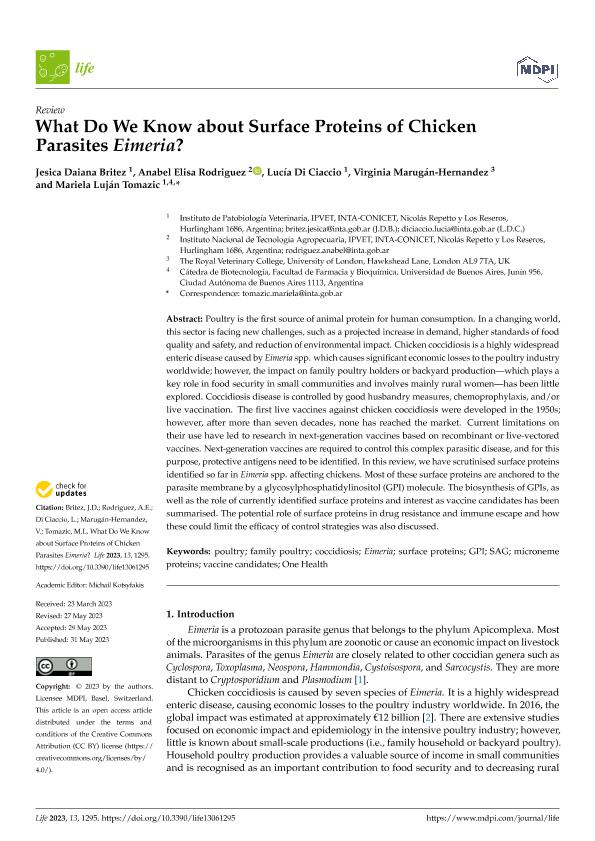Artículo
What Do We Know about Surface Proteins of Chicken Parasites Eimeria?
Britez, Jesica Daiana ; Rodriguez, Anabel Elisa
; Rodriguez, Anabel Elisa ; Di Ciaccio, Lucía Soledad
; Di Ciaccio, Lucía Soledad ; Marugán Hernandez, Virginia; Tomazic, Mariela Luján
; Marugán Hernandez, Virginia; Tomazic, Mariela Luján
 ; Rodriguez, Anabel Elisa
; Rodriguez, Anabel Elisa ; Di Ciaccio, Lucía Soledad
; Di Ciaccio, Lucía Soledad ; Marugán Hernandez, Virginia; Tomazic, Mariela Luján
; Marugán Hernandez, Virginia; Tomazic, Mariela Luján
Fecha de publicación:
06/2023
Editorial:
MDPI
Revista:
Life
ISSN:
2075-1729
Idioma:
Inglés
Tipo de recurso:
Artículo publicado
Clasificación temática:
Resumen
Poultry is the first source of animal protein for human consumption. In a changing world, this sector is facing new challenges, such as a projected increase in demand, higher standards of food quality and safety, and reduction of environmental impact. Chicken coccidiosis is a highly widespread enteric disease caused by Eimeria spp. which causes significant economic losses to the poultry industry worldwide; however, the impact on family poultry holders or backyard production—which plays a key role in food security in small communities and involves mainly rural women—has been little explored. Coccidiosis disease is controlled by good husbandry measures, chemoprophylaxis, and/or live vaccination. The first live vaccines against chicken coccidiosis were developed in the 1950s; however, after more than seven decades, none has reached the market. Current limitations on their use have led to research in next-generation vaccines based on recombinant or live-vectored vaccines. Next-generation vaccines are required to control this complex parasitic disease, and for this purpose, protective antigens need to be identified. In this review, we have scrutinised surface proteins identified so far in Eimeria spp. affecting chickens. Most of these surface proteins are anchored to the parasite membrane by a glycosylphosphatidylinositol (GPI) molecule. The biosynthesis of GPIs, as well as the role of currently identified surface proteins and interest as vaccine candidates has been summarised. The potential role of surface proteins in drug resistance and immune escape and how these could limit the efficacy of control strategies was also discussed.
Archivos asociados
Licencia
Identificadores
Colecciones
Articulos (IPVET)
Articulos de INSTITUTO DE PATOBIOLOGIA VETERINARIA
Articulos de INSTITUTO DE PATOBIOLOGIA VETERINARIA
Citación
Britez, Jesica Daiana; Rodriguez, Anabel Elisa; Di Ciaccio, Lucía Soledad; Marugán Hernandez, Virginia; Tomazic, Mariela Luján; What Do We Know about Surface Proteins of Chicken Parasites Eimeria?; MDPI; Life; 13; 6; 6-2023; 1-22
Compartir
Altmétricas



